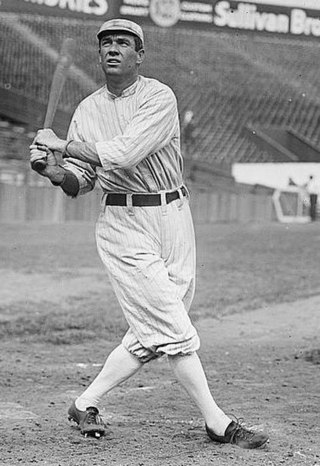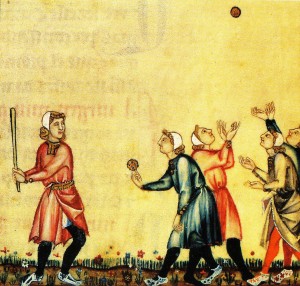Related Research Articles

In baseball statistics, a hit, also called a base hit, is credited to a batter when the batter safely reaches or passes first base after hitting the ball into fair territory with neither the benefit of an error nor a fielder's choice.

Fielding in the sport of cricket is the action of fielders in collecting the ball after it is struck by the striking batter, to limit the number of runs that the striker scores and/or to get a batter out by either catching a hit ball before it bounces, or by running out either batter before they can complete their current run. There are a number of recognised fielding positions and they can be categorised into the offside and leg side of the field. Fielding also involves trying to prevent the ball from making a boundary where four "runs" are awarded for reaching the perimeter and six for crossing it without touching the grass.

Softball is a sport similar to baseball, and it is played with a larger ball on a smaller field and with only underhand pitches permitted. Softball is played competitively at club levels, the college level, and the professional level. The game was first created in 1887 in Chicago by George Hancock.

In baseball, a double is the act of a batter striking the pitched ball and safely reaching second base without being called out by the umpire, without the benefit of a fielder's misplay or another runner being put out on a fielder's choice. A double is a type of hit and is sometimes called a "two-bagger" or "two-base hit". For statistical and scorekeeping purposes it is denoted by 2B.

In cricket, a no-ball is a type of illegal delivery to a batter. It is also a type of extra, being the run awarded to the batting team as a consequence of the illegal delivery. For most cricket games, especially amateur, the definition of all forms of no-ball is from the MCC Laws of Cricket.
The question of the origins of baseball has been the subject of debate and controversy for more than a century. Baseball and the other modern bat, ball, and running games – stoolball, cricket and rounders – were developed from folk games in early Britain, Ireland, and Continental Europe. Early forms of baseball had a number of names, including "base ball", "goal ball", "round ball", "fetch-catch", "stool ball", and, simply, "base". In at least one version of the game, teams pitched to themselves, runners went around the bases in the opposite direction of today's game, much like in the Nordic brännboll, and players could be put out by being hit with the ball. Just as now, in some versions a batter was called out after three strikes.

Throughout the history of baseball, the rules have frequently changed as the game continues to evolve. A few common rules most professional leagues have in common is that four balls is a base on balls, three strikes is a strikeout, and three outs end a half-inning.

A Spalding Hi-Bounce Ball, often called a Spaldeen or a Pensie Pinkie, is a rubber ball, described as a tennis ball core without the felt. These balls are commonly used in street games developed in the mid-20th century, such as Chinese handball, Australian Handball, stoop ball, hit-the-penny, butts up, handball, punchball, boxball, half-rubber, Wireball and stickball.
Baseball and cricket are the best-known members of a family of related bat-and-ball games. Both have fields that are 400 feet (120 m) or more in diameter between their furthest endpoints, offensive players who can hit a thrown/"bowled" ball out of the field and run between safe areas to score runs (points) at the risk of being gotten out, and have a major game format lasting about 3 hours.

Bat-and-ball games are field games played by two opposing teams. Action starts when the defending team throws a ball at a dedicated player of the attacking team, who tries to hit it with a bat and run between various safe areas in the field to score runs (points). The defending team can use the ball in various ways against the attacking team's players to force them off the field when they are not in safe zones, and thus prevent them from further scoring. The best known modern bat-and-ball games are cricket and baseball, with common roots in the 18th-century games played in England.
Old cat games were bat-and-ball, safe haven games played in North America. The games were numbered according to the number of bases. The number of bases varied according to the number of players. Only one old cat continues to be commonly played in the 21st century.
This is an alphabetical list of selected unofficial and specialized terms, phrases, and other jargon used in baseball, along with their definitions, including illustrative examples for many entries.
Wireball is a street game related to baseball, usually formed as a pick-up game, in urban areas of the United States. The equipment consists of a pimple or pensie pinkie ball and a convenient place in a street or driveway where an electric power line or group of power lines bisect horizontally. The rules come from baseball and are modified to fit the situation. It can be played with one or more persons per team.
Pinners is a Chicago neighborhood game played on the front-stoop or walls with angled bricks/stones which can be used to pop the ball up in the air. References and accounts of playing exist to 1949 or earlier. The batter would throw a rubber/tennis ball at the edge of the step or angled wall brick, and the fielder(s) would try to catch the ball as it bounces back. The ball used was a two and a half-inch hollow pink soft rubber ball called a "Pinky," that bounced well off the edges of steps. Baseball gloves were not allowed. The scoring rules is similar to baseball, but with runs being virtual determined by where the ball lands. A single, double, triple or home run would be predetermined landmarks from the batting area. A catch is an out, and a one-handed catch could be used for a "rushie." As with most neighborhood games, rules varied by the groups playing and house rules would be determined at the start of the game, including the base locations. The game utilizes traditional Chicago neighborhood row house architecture, with most houses having front stairs or a stoop that leads from the front door to the sidewalk. Many of the schools built in Chicago have a horizontal perfectly angled section of decorative brick, at the right height, that was used for the game.

Baseball is a bat-and-ball sport that has many recreational variants. The major sport most related to baseball is the Olympic discipline of softball, with the two sports being administered internationally alongside Baseball5 by the World Baseball Softball Confederation.
The traditional games of New York City are one of the notable aspects of New York City's culture; many of them were brought over by the diverse mix of immigrants that settled in New York City, particularly from Europe. Many of these games used street furniture and other features of New York City's high urban density and were therefore also played in other cities of the United States. Most of these games have declined or disappeared in the modern era.
References
- ↑ "NYCdata | Uniquely NYC". www.baruch.cuny.edu. Retrieved 2021-09-21.
- ↑ Maguire, Jack (1990). Hopscotch, Hangman, Hot Potato, & Ha Ha Ha: A Rulebook of Children's Games. Simon and Schuster. ISBN 978-0-671-76332-9.
- ↑ "Stoopball at". Streetplay.com. September 21, 2006. Retrieved March 18, 2010.[ unreliable source? ]
- ↑ Schupak, Marty. "Stoop Ball on". Webball.com. Retrieved March 18, 2010.
- ↑ "Official Rules – Stoopball League of America". Stoopball.ning.com. Retrieved March 18, 2010.
- ↑ "Stoopball - Curbball". Streetplay.com. Archived from the original on 11 February 2021.[ unreliable source? ]
- ↑ "Stoopball (Original)". Streetplay.com. Archived from the original on 11 February 2021.[ unreliable source? ]
- ↑ United States Patent # 5531449 "portable stoopball striker"
- ↑ "Harvey Frommer on Sports". Travel-watch.com. January 13, 2009. Retrieved March 18, 2010.
- ↑ Beller, Thomas (November 17, 2005). "Mr. Beller's neighborhood". Mrbellersneighborhood.com. Retrieved March 18, 2010.
- ↑ "Growing up Billy Joel". Courant.com. Retrieved March 18, 2010.
- ↑ Hector Elizondo (narrator); Matt Levy (director). New York Street Games (Motion picture). New York City. Retrieved 14 November 2011.